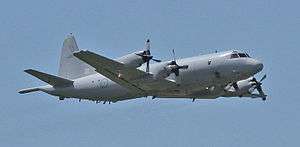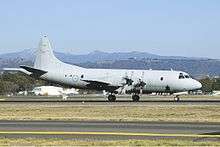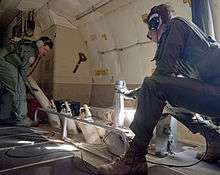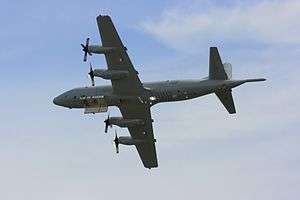Lockheed AP-3C Orion
| AP-3C Orion | |
|---|---|
 | |
| AP-3C Orion | |
| Role | Maritime patrol aircraft |
| National origin | United States / Australia |
| Manufacturer | Lockheed Corporation Sensor systems by L3 Communications / Tenix Defence |
| First flight | 19 May 1999 |
| Introduction | 2002 |
| Status | Active |
| Primary user | Royal Australian Air Force |
| Number built | 18 |
| Developed from | Lockheed P-3 Orion |
The Lockheed AP-3C Orion is a variant of the P-3 Orion used by the Royal Australian Air Force (RAAF) for tasks such as naval fleet support, maritime surveillance, search and survivor supply and anti-surface and anti-submarine warfare. The 18 AP-3C Orions were upgraded from P-3Cs between 1997 and 2005, with the program taking three years longer than expected due to systems integration problems. All 18 AP-3C Orions are operated by No. 92 Wing which is based at RAAF Base Edinburgh in South Australia. Aircraft from the wing have seen service as part of Australian Defence Force operations in Australia, South East Asia and the Middle East.
Development
The AP-3C Orion project began in the early 1990s to upgrade the radar and mission systems on 18 of Australia's 19 P-3C-II Orions. L3 Communications completed the prototype AP-3C at its facility at Greenville, Texas. The other 17 aircraft were upgraded at Avalon Airport in Australia under a sub-contract to Australian companies. Tenix Defence took over the project in mid-2003 and BAE Systems was involved with many of the aircraft's sub-systems and developing a simulation facility.[1] Work began on the first AP-3C in January 1997 and the original project schedule called for this aircraft to be provided to the RAAF for operational acceptance trials in March 1998 and all upgrades to be completed by the end of 2001.[2] The remaining 19th Orion was not included in the upgrade program, and the Australian military stated in 2005 that it is "used for development purposes".[3]
When the Australian Orion upgrade project was being developed in 1996 there was not an 'off the shelf' package of upgrades that met the requirements specified by the RAAF. As a result, it was decided to tailor the upgrade to Australian specifications, which included integrating different systems. The systems integration task proved to be much more difficult than was expected, and L3 Communications and its suppliers were required to write over two million lines of software code.[4]
As a result of the systems integration problems delivery of upgraded Orions was delayed by three years. The first two aircraft were handed over to the RAAF in December 2001[5] and the final AP-3C was delivered in early 2005.[1] This delay caused a major reduction in the RAAF's maritime surveillance capability, and in February 2001 only nine of the RAAF's 17 Orions were operational.[2]
Capabilities


The AP-3C upgrade improved the Orions' radar, intelligence-gathering and computing systems. The upgrade included fitting each aircraft with a new Elta EL/M-2022(V)3 radar, a nose-mounted Star Safire III electro-optical and infrared system, "highly capable" signals and electronic intelligence (SIGINT/ELINT) equipment, the UYS 503 acoustic system, a new automatic information system processor, a new navigation system based on two Honeywell H764G Embedded GPS/INUs, a new communications system and other improvements. The Orions' weight was also reduced by more than 3,000 kilograms (6,600 lb) as part of the upgrade.[3][6]
The AP-3Cs' new radar and electronic surveillance system greatly increased the capabilities of the RAAF's Orion fleet. These new systems allow the Orions to detect and identify more targets and at longer range. In 2002 the then-Chief of Air Force Air Vice Marshal Angus Houston claimed that the AP-3Cs were the best maritime patrol aircraft in the world and The Australian reported that they were superior to the United States Navy's Orions, though an upgrade was planned for the USN's Orion fleet.[4]
There has been speculation that one or more of the AP-3Cs was fitted with additional SIGINT/ELINT capabilities and operate as specialised intelligence-gathering aircraft. An article in the magazine Australian Aviation in December 2007 stated that this is probably not correct, and it is more likely that several SIGINT/ELINT 'kits' were purchased and can be swapped between all 18 airframes. The magazine also quoted an unnamed 'industry source' as stating that all the AP-3Cs have SIGINT/ELINT capabilities "equivalent or better" than those of the Royal Air Force's specialised Hawker Siddeley Nimrod surveillance aircraft.[3] Jane's World Air Forces states that the RAAF's 19th Orion was converted to an EP-3 signals reconnaissance aircraft in 1997, however, and was operational as late as 2009.[7]
The aircraft are equipped with AGM-84 Harpoon anti-ship missiles, Mark 46 or MU90 Impact torpedoes, mines, and a range of sonar buoys and other stores.[8][9]
AP-3C Orions have a normal crew complement of 13, broken down as follows:[10]
- two pilots (captain and co-pilot)
- two flight engineers
- tactical co-ordinator
- navigator/communication officer
- sensor employment manager
- six airborne electronic analysts.
In addition to their traditional maritime surveillance role, AP-3Cs have been equipped for over-land surveillance roles. As of 2007, the RAAF's two-aircraft Orion detachment in the Middle East was spending 60 percent of its flying time conducting intelligence gathering, surveillance and reconnaissance over Iraq.[11]
On 14 May 2007 BAE Systems Australia was awarded an $76.1 million contract to provide an upgraded electronic support measures (ESM) system for the Orions. The contract involved replacing existing sub-systems and ground support systems from 2011.[12]
In 2008 the Australian Government awarded contracts for further enhancements to the AP-3C fleet. Under this project 18 Orions were to be equipped with new electro-optical/infrared sensors, tactical common datalinks and video recorders by 2011.[13]
Operational history

All AP-3Cs were assigned to No. 92 Wing RAAF, which forms part of the air force's Surveillance and Response Group. Each of the 18 aircraft is permanently allocated to either No. 10 Squadron or No. 11 Squadron rather than being placed in a wing-owned pool.[14] AP-3C aircraft are also used by the RAAF's Orion operational conversion unit, No. 292 Squadron, for training flights.
The AP-3Cs have seen extensive operational service. The first operational deployment of one of the upgraded aircraft was conducted in late 2002, when an AP-3C assigned to No. 10 Squadron flew border protection patrols from Darwin.[15] The Orions have subsequently formed an important part of Operation Resolute, the Australian Defence Force's contribution to patrolling Australia's Exclusive Economic Zone. As part of this operation Orions fly regular missions around Australia's western and northern approaches and report the results of their patrols to Border Protection Command.[14] AP-3Cs also periodically conduct patrols over the Indian Ocean, Strait of Malacca and South China Sea from RMAF Butterworth in Malaysia as part of Operation Gateway.[14] A single AP-3C was also deployed to Pago Pago in American Samoa during November and December 2006 to support the Australian force deployed off Fiji in response to the 2006 Fijian coup d'état.[16]
Further afield, a detachment of two AP-3Cs was based in the Middle East from 2003 until late 2012 as part of Australia's commitment to the War on Terrorism (Operation Slipper) and the Iraq War (Operation Catalyst). These aircraft conducted maritime surveillance patrols over the Persian Gulf and North Arabian Sea; providing support to Coalition warships and boarding parties; and conducting extensive overland flights of Iraq to support the Coalition ground forces there. By December 2007 the AP-3C detachment had conducted 1,200 sorties totaling more than 11,000 hours of flying.[14] The aircraft also operated over Afghanistan conducting intelligence, surveillance and reconnaissance missions, as well supporting counter-piracy operations in Somalia. This deployment ended in December 2012; by this time the aircraft had flown over 2,400 sorties; and more than 3,500 No. 92 Wing personnel had served in the Middle East.[17]
In February 2009 an AP-3C Orion conducted flights over the state of Victoria in which it used its sophisticated cameras to map the damage and destruction caused by the Black Saturday bushfires and to search for survivors.[18]

In March 2014, four AP-3Cs participated in the search for Malaysia Airlines Flight 370.
In December 2015, it was reported by the BBC that an AP-3C Orion aircraft from the Royal Australian Air Force conducted freedom of navigation exercises over contested islands in the South China Sea.[19] The Department of Defence released a statement stating that the Orion had conducted routine maritime patrols between 25 November and 4 December as part of a regular surveillance operation. The aircraft was operating as a part of Operation Gateway, Australia's "enduring contribution to the preservation of regional security and stability in South East Asia".[20][21][22]
Replacement
The RAAF's Orions are expected to be replaced by up to a dozen Boeing P-8 Poseidons and six to eight MQ-4C Triton[23] unmanned aerial vehicles between 2015 and 2018.[24][25] One of the Orions was retired in 2012 or 2013.[26] This aircraft, which was the only one to have not been upgraded to AP-3C status, was scrapped on 20 October 2014. At this time the RAAF planned to reduce the Orion fleet to 16 aircraft by the end of 2014 and retire the type in 2019.[27]
Operators
Specifications (AP-3C Orion)

General characteristics
- Crew: 13
- Length: 116 ft 10 in (35.6 m)
- Wingspan: 101 ft 6 in (30.8 m)
- Height: 34 ft 3 in (10.44 m)
- Wing area: 1300 ft² (120.8 m²)
- Empty weight: 27,900 kg ()
- Loaded weight: lb (kg)
- Max. takeoff weight: 61,200kg (63,400 kg)
- Powerplant: 4 × Allison T56-A-14 turboprop, 4,600 shp (3,700 kW) each
Performance
- Maximum speed: 750 km/h (405 knots)
- Range: 2,700 miles combat / 5,600 miles ferry (4,400 km / 9,000 km)
- Service ceiling: 28,300 ft (8,600 m)
- Rate of climb: 3,140 ft/min (957 m/min)
- Wing loading: 107 lb/ft² (530 kg/m²)
- Power/mass: 0.03 hp/lb (0.06 kW/kg)
Notes
- 1 2 "Upgraded Orion fleet now in service". Australian Associated Press. 2005-03-15.
- 1 2 "Updated Orion unveiled after three years delay.". Flight International. 2001-02-20.
- 1 2 3 McCaughlin (2007). "Quiet Achiever": 41.
- 1 2 "Refit gives Orions a new lease of life". The Australian. 2002-11-15.
- ↑ "Orion systems update back on track". The Australian. 2001-11-30.
- ↑ "Updated Orion Aircraft Delivered To The RAAF". Forecast International. 2001-12-08.
- ↑ Peacock, Lindsay; Keymer, Eleanor (2009). Jane's World Air Forces. Issues Twenty-Nine. Coulsdon: Jane's Information Group. p. 31. ISSN 1748-2526.
- ↑ Wilson, Stewart (1994). Military Aircraft of Australia. Weston Creek, ACT: Aerospace Publications. pp. 141–142. ISBN 1875671080.
- ↑ "Remediation of the Lightweight Torpedo Replacement Project". Australian National Audit Office. 28 February 2013. Retrieved 27 June 2015.
- ↑ "AP-3C Orion maritime patrol aircraft". Royal Australian Air Force. Archived from the original on December 19, 2008. Retrieved 2008-11-28.
- ↑ Skehan, Craig (2007-06-08). "Spy plane mission revealed". The Sydney Morning Herald.
- ↑ "In Brief". Journal of Electronic Defense. 60 (6). 2007. ISSN 0192-429X.
- ↑ Kelly, Emma (2008-08-26). "Canberra agrees to upgrade AP-3C Orion fleet". Flight International.
- 1 2 3 4 McCaughlin (2007). "Quiet Achiever": 44.
- ↑ Nott, Deanna (21 November 2002). "AP-3C patrols nation's north". Air Force News. Retrieved 1 March 2015.
- ↑ "Australian task group returns from Fiji". The Age. 2006-12-17. Retrieved 2008-11-30.
- ↑ "Mission complete on wings of a dream craft". Adelaide Now. Retrieved 10 March 2013.
- ↑ Dodd, Mark (2009-02-10). "RAAF 'spy' plane searches for survivors and maps damage". The Australian. Retrieved 2009-02-10.
- ↑ "Australia conducting 'freedom of navigation' flights in South China Sea". BBC News. 15 December 2015. Retrieved 15 December 2015.
- ↑ "Operation Gateway". South China Sea Indian Ocean. Department of Defence. Retrieved 15 December 2015.
- ↑ "Defence claims RAAF South China Sea flight is "routine"". Australian Financial Review. 15 December 2015. Retrieved 15 December 2015.
- ↑ Greene, Andrew; Birtles, Bill (15 December 2015). "Audio captures RAAF surveillance flight over South China Sea". ABC News. Retrieved 15 December 2015.
- ↑ "PM gives go-ahead to buy Triton drones". news.com.au. 15 March 2014.
- ↑ Ferguson, Gregor (2008-11-29). "Crossroads for maritime surveillance deal". The Australian.
- ↑ "PM gives go-ahead to buy Triton drones". NewsComAu.
- ↑ "Budget reveals RAAF Orion retirement". Australian Aviation. 15 May 2013. Retrieved 19 May 2013.
- ↑ "RAAF Orion drawdown begins". Australian Aviation. 27 October 2014. Retrieved 15 November 2014.
References
- BAE Systems
- "AP-3C Orion maritime patrol aircraft". Royal Australian Air Force. Retrieved 2014-02-24.
- Australian National Audit Office (2005). Upgrade of the Orion Maritime Patrol Aircraft Fleet (PDF). Canberra: ANAO. ISBN 0-642-80867-8.
- McCaughlin, Andrew (2007). "Quiet Achiever". Australian Aviation (December 2007).
External links
| Wikimedia Commons has media related to AP-3C Orion. |
- Farquhar, Rod. "ADF Aircraft Serial Numbers RAAF A9 Lockheed AP-3C, P-3B/C, TAP-3B Orion". ADF Serials.